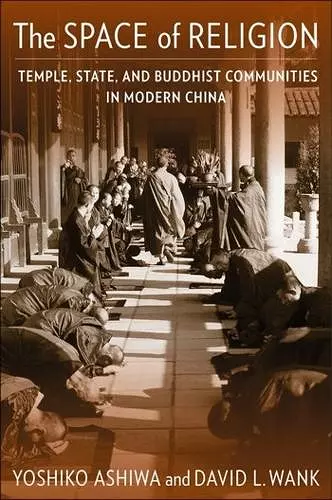The Space of Religion
Temple, State, and Buddhist Communities in Modern China
David L Wank author Yoshiko Ashiwa author
Format:Paperback
Publisher:Columbia University Press
Published:26th Sep '23
Should be back in stock very soon

Finalist, 2024 Award for Excellence in the Study of Religion in Analytical-Descriptive Studies, American Academy of Religion
Honorable Mention, 2024 Francis H.K. Hsu Book Prize, Society for East Asian Anthropology
The Nanputuo Temple in the southeastern Chinese city of Xiamen has been a cherished site for the worship of the bodhisattva Guanyin for centuries. It was a center of modernizing Buddhism in the early twentieth century and a flagship for the revival of Buddhism after state suppression during the Cultural Revolution. The Space of Religion takes readers inside the Nanputuo Temple in order to explore the practice of Buddhism in modern China and the complex relationship between Buddhism and the Chinese state.
Based on three decades of ethnographic research, Yoshiko Ashiwa and David L. Wank tell the story of Nanputuo against the backdrop of a dramatic stretch of Chinese history. They vividly depict episodes such as renovating the halls, reestablishing ties with overseas Chinese donors, conflicts with local government, revival of ritual life, reopening of its Buddhist academy, and the passion of the Guanyin birthday festival. To understand Nanputuo, Buddhist communities, and other temples in Xiamen, Ashiwa and Wank develop the concept of religion as a space constituted by physical, semiotic, and institutional dimensions. They also show how the Chinese state and Buddhism have each adapted to the other, as the temple has adjusted to government policy while the state has deployed Buddhism in its promotion of Chinese culture.
This interdisciplinary book is both a theoretically generative analysis of religious spaces and an empirically rich account of the recovery of Buddhism in China after the Mao era.
Based on extraordinarily rich ethnography, deep historical research, and a subtle theoretical framework, The Space of Religion shows how one of China’s most important temples reemerged, changed, and caused transformations of its political and cultural contexts over the past several decades. It makes a major advance toward understanding the surprising and consequential rise of a dynamic space for religion in China. -- Richard Madsen, coeditor of The Sinicization of Chinese Religions: From Above and Below
The Space of Religion provides a detailed description through extended fieldwork of the functioning of an important Buddhist monastery in China and how the temple 'space' became recomposed on three levels—physical, institutional, and semiotic—after the Cultural Revolution. In doing so, Ashiwa and Wank produce an analysis of the transformation of state policies and related public perception of religion in China. -- Ji Zhe, coeditor of Making Saints in Modern China
The Space of Religion is far more than just a very valuable account of institutional change in a Buddhist context. It also outlines a fresh and important critical analysis, grounded in historical detail and exemplary ethnography, of how the concepts ‘religion,’ ‘superstition,’ and ‘culture’ emerged and were enacted (and contested) between the state, clerics, and the people over the last hundred years of Chinese history. -- David N. Gellner, coauthor of Rebuilding Buddhism: The Theravada Movement in Twentieth-Century Nepal
Ashiwa and Wank have written a superb account, both historical and ethnographic, of Nanputuo, one of the most important Buddhist temples in southern China. Based on decades of intensive study, this immensely readable book offers insights into the developments that have shaped the political environment in which the temple's clerics operate. It also gives a theoretically astute interpretation of the semiotics of space in the temple that allows the reader to get a feeling for the ways in which the teachings of the Buddha take material and ritual shape in the temple's space. For anyone interested in Buddhism or contemporary Chinese society this book is invaluable and a must-read. -- Peter van der Veer, author of The Modern Spirit of Asia: The Spiritual and the Secular in China and India
Essential reading for scholars of Buddhism in modern China and a valuable resource for China specialists and students interested in state–religion dynamics in the People’s Republic. * China Quarterly *
A remarkable study of the role of Buddhism as a space in the modern transformation of China from the late-19th century to the present...Highly recommended. * Choice *
Offers a vast amount of data culled from diverse sources that vividly illustrates the recovery of Buddhism at one of the most important temple complexes in southern China. * H-Buddhism *
I am amazed by the extraordinary depth, meticulousness, and insight that characterised The Space of Religion. The book’s wealth of ethnographic material, combined with its exceptionally nuanced analysis, renders it an invaluable resource for students and scholars of Chinese religions and modern Chinese society. -- Xiangyi Lin * Religion *
Grants the reader an invaluable insight into the history of an incredibly important temple in the PRC. * Religious Studies Review *
This book will appeal to students of Chinese Buddhism, comparative religion, sociologists of religion, ... with a special interest in the functioning of a real living temple in its historical and social contexts. * Acta Comparanda *
'The Space of Religion' is an essential read for anyone interested in Buddhism in modern China and Chinese religions more broadly. Its approach of three dimensions of religion will inspire readers who are interested in theories of material religion to explore religious space in traditions elsewhere. * Material Religion *
- Commended for Francis L.K. Hsu Book Prize, Society for East Asian Anthropology 2024
- Short-listed for Award for Excellence in the Study of Religion in Analytical-Descriptive Studies, American Academy of Religion 2024
ISBN: 9780231197359
Dimensions: unknown
Weight: unknown
440 pages